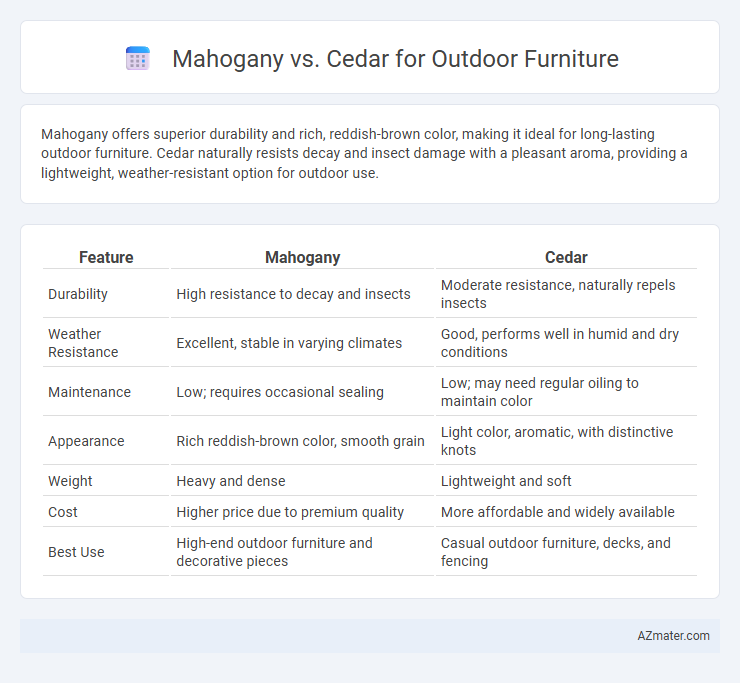Mahogany offers superior durability and rich, reddish-brown color, making it ideal for long-lasting outdoor furniture. Cedar naturally resists decay and insect damage with a pleasant aroma, providing a lightweight, weather-resistant option for outdoor use.
Table of Comparison
| Feature | Mahogany | Cedar |
|---|---|---|
| Durability | High resistance to decay and insects | Moderate resistance, naturally repels insects |
| Weather Resistance | Excellent, stable in varying climates | Good, performs well in humid and dry conditions |
| Maintenance | Low; requires occasional sealing | Low; may need regular oiling to maintain color |
| Appearance | Rich reddish-brown color, smooth grain | Light color, aromatic, with distinctive knots |
| Weight | Heavy and dense | Lightweight and soft |
| Cost | Higher price due to premium quality | More affordable and widely available |
| Best Use | High-end outdoor furniture and decorative pieces | Casual outdoor furniture, decks, and fencing |
Introduction to Mahogany and Cedar for Outdoor Furniture
Mahogany is prized for its rich reddish-brown color, exceptional durability, and natural resistance to rot and insects, making it an ideal choice for outdoor furniture. Cedar offers a lightweight yet sturdy option, known for its aromatic scent, natural oils that deter pests, and ability to withstand moisture and decay. Both woods require proper maintenance but provide long-lasting performance and distinctive aesthetics for outdoor settings.
Key Differences Between Mahogany and Cedar
Mahogany offers exceptional durability and resistance to rot and insects due to its dense grain, making it ideal for long-lasting outdoor furniture, whereas cedar is naturally aromatic with good resistance to decay but is softer and more prone to dents. The rich reddish-brown hue of mahogany deepens over time, providing a luxurious aesthetic, while cedar's lighter, warm tones tend to weather to a silvery gray if left untreated. Maintenance for mahogany typically involves regular sealing to preserve its finish, whereas cedar requires periodic oiling or staining to maintain its vibrant color and prevent weathering.
Durability and Weather Resistance
Mahogany offers exceptional durability and resistance to rot, insects, and decay, making it a top choice for outdoor furniture that withstands harsh weather conditions. Cedar naturally contains oils that provide excellent weather resistance and repel moisture, reducing the risk of warping and cracking over time. While both woods perform well outdoors, mahogany's dense grain and hardness generally provide superior longevity compared to the lighter, softer cedar.
Appearance and Aesthetic Appeal
Mahogany offers rich, warm reddish-brown hues with a fine, straight grain that deepens over time, providing a luxurious and classic aesthetic ideal for elegant outdoor furniture. Cedar features a lighter, natural reddish tone with distinctive knots and a more rustic, textured grain, enhancing outdoor spaces with a casual, cozy charm. Both woods are prized for their natural beauty, but mahogany's smooth finish and color depth make it a preferred choice for sophisticated, high-end outdoor designs.
Maintenance Requirements
Mahogany requires regular cleaning and periodic oiling to maintain its rich color and prevent drying or cracking, while cedar demands less maintenance due to its natural resistance to rot and insects, needing occasional cleaning and light resealing. Both woods benefit from protection against prolonged sun exposure to avoid fading, but cedar's innate oils help preserve its structural integrity with minimal intervention. Choosing between mahogany and cedar for outdoor furniture depends heavily on the desired balance between luxurious appearance and ease of upkeep.
Cost Comparison
Mahogany outdoor furniture typically costs between $150 to $300 per chair due to its dense grain and durability, making it a premium choice. Cedar is more budget-friendly, usually ranging from $100 to $200 per chair, valued for its natural resistance to decay and lighter weight. While mahogany's higher price reflects long-term investment with superior hardness, cedar offers affordability paired with adequate weather resistance.
Sustainability and Eco-Friendliness
Mahogany is a dense hardwood prized for its durability but often sourced from tropical rainforests, raising sustainability concerns due to deforestation and slow growth rates. Cedar, particularly Western Red Cedar, is considered more eco-friendly because it grows faster, is often harvested from sustainably managed forests, and naturally resists decay without chemical treatment. Choosing Cedar for outdoor furniture supports better sustainability practices and reduces ecological impact compared to many mahogany varieties.
Workability and Ease of Construction
Mahogany offers excellent workability due to its fine, straight grain and uniform texture, allowing for smooth cutting, sanding, and shaping, which makes it a favored choice for intricate outdoor furniture designs. Cedar is lighter and softer, providing good ease of construction with less effort to machine and fasten, although it may splinter more easily compared to mahogany. Both woods resist decay well, but mahogany's density grants superior durability and a smoother finish, enhancing its appeal for long-lasting, finely crafted outdoor furniture.
Best Applications for Mahogany vs Cedar
Mahogany is best suited for outdoor furniture requiring exceptional durability, rich color, and a smooth finish, making it ideal for high-end patio sets and detailed carvings. Cedar excels in applications where natural resistance to insects and rot is essential, often preferred for lightweight furniture like garden benches and Adirondack chairs. Both woods perform well outdoors, but mahogany offers greater structural strength while cedar provides superior aromatic qualities and weather resistance.
Final Verdict: Which Wood is Right for Your Outdoor Furniture?
Mahogany offers exceptional durability and rich, deep color, making it ideal for outdoor furniture that requires a luxurious appearance and long-lasting performance. Cedar is naturally resistant to insects and decay, with a lighter weight and distinct aroma, perfect for budget-friendly, low-maintenance outdoor furniture. Choose mahogany for premium aesthetics and longevity, while cedar excels in affordability and resistance to environmental elements.

Infographic: Mahogany vs Cedar for Outdoor furniture
 azmater.com
azmater.com